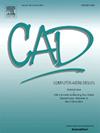向着受参数曲面约束的精确曲线偏移
IF 3.1
3区 计算机科学
Q2 COMPUTER SCIENCE, SOFTWARE ENGINEERING
引用次数: 0
摘要
在计算机辅助设计和制造中,计算参数化曲面上曲线的偏移量是一项基本但具有挑战性的操作。传统的分析方法受到耗时的测地线距离查询和复杂的自交处理的困扰,而离散方法往往难以达到精度。在本文中,我们提出了一个完全不同的算法范式。我们的关键见解是,通过将源曲线表示为线段原语序列,Voronoi分解约束于参数表面,可以实现局部偏移计算。具体来说,通过独立访问相应的Voronoi细胞,可以有效地跟踪抵消过程。为了解决在参数曲面上计算Voronoi分解的挑战,我们引入了两个关键技术。首先,我们在参数空间中使用内禀三角剖分来精确捕获测地线距离。其次,我们使用一系列的平面切割操作来分解三角化参数平面,而不是直接计算表面约束的Voronoi分解。实验结果表明,与现有方法相比,该算法具有更高的精度和运行时间性能。我们还介绍了通过我们的方法实现的几个实际应用。本文章由计算机程序翻译,如有差异,请以英文原文为准。
Toward precise curve offsetting constrained to parametric surfaces
Computing offsets of curves on parametric surfaces is a fundamental yet challenging operation in computer-aided design and manufacturing. Traditional analytical approaches suffer from time-consuming geodesic distance queries and complex self-intersection handling, while discrete methods often struggle with precision. In this paper, we propose a totally different algorithm paradigm. Our key insight is that by representing the source curve as a sequence of line-segment primitives, the Voronoi decomposition constrained to the parametric surface enables localized offset computation. Specifically, the offsetting process can be efficiently traced by independently visiting the corresponding Voronoi cells. To address the challenge of computing the Voronoi decomposition on parametric surfaces, we introduce two key techniques. First, we employ intrinsic triangulation in the parameter space to accurately capture geodesic distances. Second, instead of directly computing the surface-constrained Voronoi decomposition, we decompose the triangulated parameter plane using a series of plane-cutting operations. Experimental results demonstrate that our algorithm achieves superior accuracy and runtime performance compared to existing methods. We also present several practical applications enabled by our approach.
求助全文
通过发布文献求助,成功后即可免费获取论文全文。
去求助
来源期刊

Computer-Aided Design
工程技术-计算机:软件工程
CiteScore
5.50
自引率
4.70%
发文量
117
审稿时长
4.2 months
期刊介绍:
Computer-Aided Design is a leading international journal that provides academia and industry with key papers on research and developments in the application of computers to design.
Computer-Aided Design invites papers reporting new research, as well as novel or particularly significant applications, within a wide range of topics, spanning all stages of design process from concept creation to manufacture and beyond.
 求助内容:
求助内容: 应助结果提醒方式:
应助结果提醒方式:


